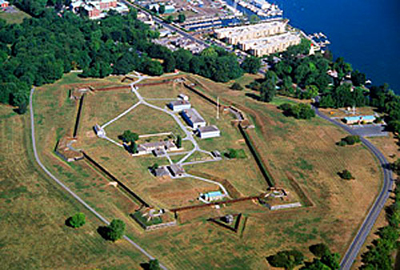Fort George National Historic Site of Canada
Niagara-on-the-Lake, Ontario

Aerial view
© Parks Canada Agency / Agence Parcs Canada, G. Vandervlugt, 2001.
Address :
Queen's Parade Road, Niagara-on-the-Lake, Ontario
Recognition Statute:
Historic Sites and Monuments Act (R.S.C., 1985, c. H-4)
Designation Date:
1921-05-21
Dates:
-
1796 to 1799
(Construction)
-
1796 to 1815
(Significant)
Event, Person, Organization:
-
Battle of Fort George
(Event)
-
War of 1812
(Event)
-
Captain Runchey’s Company of Coloured Men
(Organization)
Other Name(s):
-
Fort George
(Designation Name)
DFRP Number:
30313 00
Plaque(s)
Constructed by order of Lieutenant-Governor Simcoe, 1796-99, Fort George served as the headquarters for Major-General Brock in 1812. In May, 1813, it was bombarded and captured by the Americans who constructed fortifications of their own on the site. These in turn were retaken by the British in December, 1813. In 1815 Fort George was described as "tumbling into ruins" and ordered abandoned. The present works are a reconstruction done in 1937-40, and represent the fort as it was in 1799-1813. Only the magazine of the original fort remains.
Description of Historic Place
Fort George National Historic Site of Canada is a largely recreated 18th-century military fort located on the west bank of the Niagara River near the river's mouth. It is situated on the remains of the original Fort George, largely destroyed during the War of 1812.
Heritage Value
Fort George was declared a national historic site because: it served as the principal fortification on the Niagara Peninsula during the War of 1812 and as Headquarters of the Central Division of the British Army, it played a key role in the defence of Upper Canada, its destruction by artillery contributed to the American victory in the Battle of Fort George and the subsequent seven-month occupation by American forces.
The heritage value of Fort George lies in the remnants of a late 18th-century British fortification embedded in its cultural landscape, and the residues of the history to which they bear witness, particularly those associated with the War of 1812, the Battle of Fort George, British and American occupancy of the fortress, and its destruction in May 1813. Fort George was the site of a historic reconstruction during the 1930s, an activity which reconfigured most of its earthworks and resulted in the construction of several buildings inside the footprint of the original fort.
Sources: HSMBC Minutes, October 1963; Commemorative Integrity Statement.
Character-Defining Elements
Key features contributing to the heritage value of this site include:
archaeological remnants of the Battle of Fort George, British and American occupancy, the original fortification with its palisade and the sloping glacis, buildings, structures, and landscape features, the massing, form, materials and craftsmanship of the powder magazine, particularly its stone construction and buttressed bomb- and fire-proof walls, the location of the powder magazine, away from other buildings, the spatial inter-relationships between the remains of original facilities inside the palisade, the core of "original Fort George dirt" in the rebuilt earthworks and any indications of the outline of the earthworks of the original fortification, the remaining natural topographical features of the site, particularly as they are integrated with military requirements (such as the natural ravine in which the powder magazine is located), the extensive cleared area extending to the Niagara River and across the Commons, archaeological remains of life at the fortress witnessing both British and American occupancy (including American trench lines both above and below grade, remnants of wharves, buildings, supply yards of Navy Hall), archaeological remains of the Battle of Fort George and destruction of the fort, the siting of the fortress on a steep rise, near the mouth of the river, evidence of 1930s commemorative activities on the site which re-configured its earthworks and added new buildings, viewplanes from the fort to the river, Butler's Barracks, the town, and across the river to the former site of the American Fort Niagara.